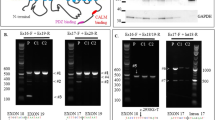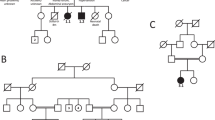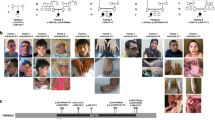Abstract
Lack of a maternal contribution to the genome at the imprinted domain on proximal chromosome 15 causes Angelman syndrome (AS) associated with neurobehavioral anomalies that include severe mental retardation, ataxia and epilepsy1,2. Although AS patients have infrequent mutations in the gene encoding an E6-AP ubiquitin ligase required for long-term synaptic potentiation (LTP), most cases are attributed to de novo maternal deletions of 15q11–q13 (ref. 3). We report here that a novel maternally expressed gene, ATP10C, maps within the most common interval of deletion and that ATP10C expression is virtually absent from AS patients with imprinting mutations, as well as from patients with maternal deletions of 15q11–q13.
This is a preview of subscription content, access via your institution
Access options
Subscribe to this journal
Receive 12 print issues and online access
$209.00 per year
only $17.42 per issue
Buy this article
- Purchase on Springer Link
- Instant access to full article PDF
Prices may be subject to local taxes which are calculated during checkout


Similar content being viewed by others
References
Nicholls, R.D., Saitoh, S. & Horsthemke, B. Trends Genet. 14, 194–200 (1998).
Jiang, Y., Tsai, T.-F., Bressler, J. & Beaudet, A.L. Curr. Opin. Genet. Dev. 8, 334–342 (1998).
Jiang, Y., Lev-Lehman, E., Bressler, J., Tsai, T.-F. & Beaudet, A.L. Am. J. Hum. Genet. 65, 1–6 (1999).
Mutirangura, A. et al. Genomics 18, 546–5527 (1993).
Albrecht, U. et al. Nature Genet. 17, 75–78 (1997).
Mann, M.R.W. & Bartolomei, M.S. Hum. Mol. Genet. 8, 1867–1873 (1999).
Moncla, A. Eur. J. Hum. Genet. 7, 131–139 (1999).
Dittrich, B. et al. Nature Genet. 14, 163–170 (1996).
Bielinska, B. et al. Nature Genet. 25, 74–78 (2000).
Dhar, M. et al. Physiol. Genomics 4, 93–100 (2000).
Cattanach, B.M. et al. Mamm. Genome 8, 472–478 (1997).
Gillessen-Kaesbach, G. et al. Eur. J. Hum. Genet. 7, 638–644 (1999).
Halleck, M.S. et al. Physiol. Genomics 1, 139–150 (1999).
Verdaguer, N. et al. EMBO J. 18, 6329–6338 (1999).
Saitoh, S. et al. Clin. Genet. 55, 277–278 (1999).
Acknowledgements
We thank the patients and their family members for cooperation; K. Nakamura and M. Yoshida for normal Japanese samples; K. Axelsen for the P-type ATPase web page; and R. Nishigaki for technical assistance. K.M. is a postdoctoral fellow of the Japan Society for the Promotion of Science for Research Abroad. This work was supported by CREST of Japan Science and Technology Corporation, and grants from the Ministry of Education, Science, Sports and Culture of Japan and the Human Frontier Science Program Organization.
Author information
Authors and Affiliations
Corresponding author
Rights and permissions
About this article
Cite this article
Meguro, M., Kashiwagi, A., Mitsuya, K. et al. A novel maternally expressed gene, ATP10C, encodes a putative aminophospholipid translocase associated with Angelman syndrome. Nat Genet 28, 19–20 (2001). https://doi.org/10.1038/ng0501-19
Received:
Accepted:
Issue Date:
DOI: https://doi.org/10.1038/ng0501-19
This article is cited by
-
Importance of HBsAg recognition by HLA molecules as revealed by responsiveness to different hepatitis B vaccines
Scientific Reports (2021)
-
A pathway from chromosome transfer to engineering resulting in human and mouse artificial chromosomes for a variety of applications to bio-medical challenges
Chromosome Research (2015)
-
An Aminophospholipid Translocase Associated with Body Fat and Type 2 Diabetes Phenotypes
Obesity Research (2002)



